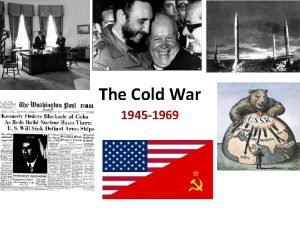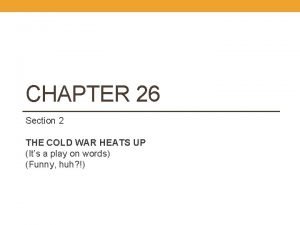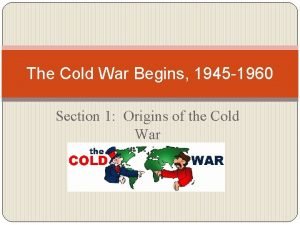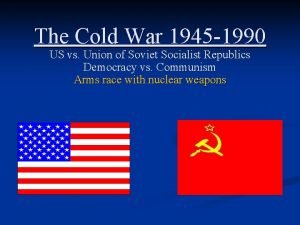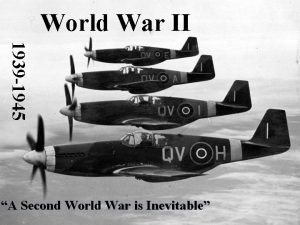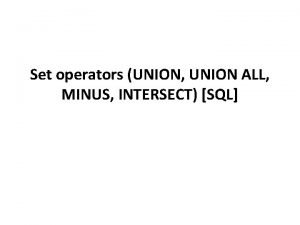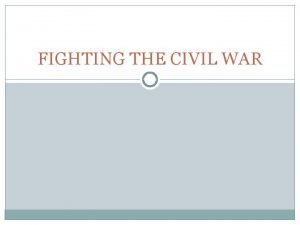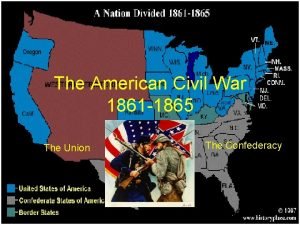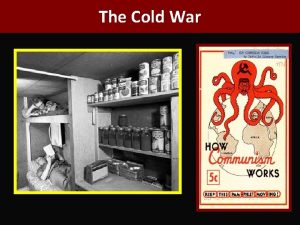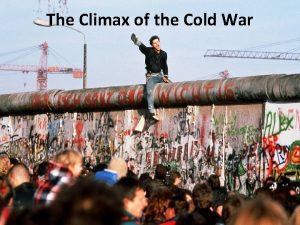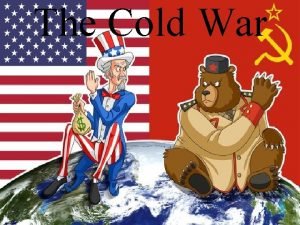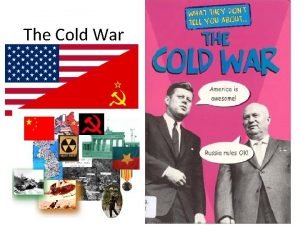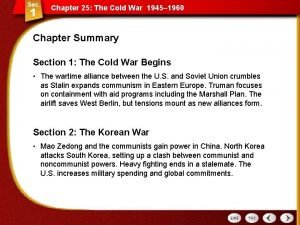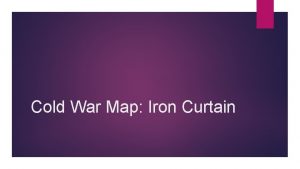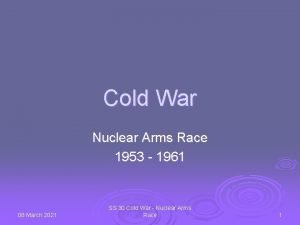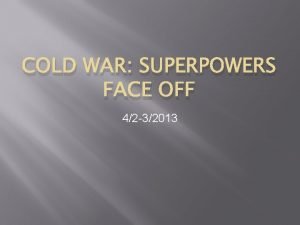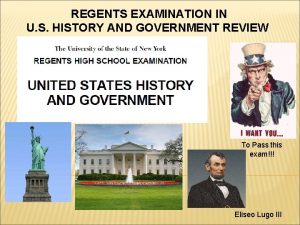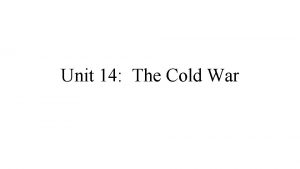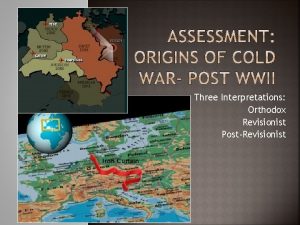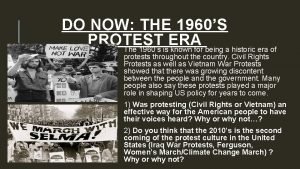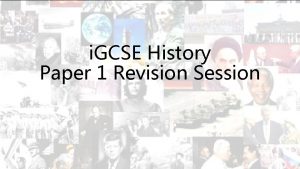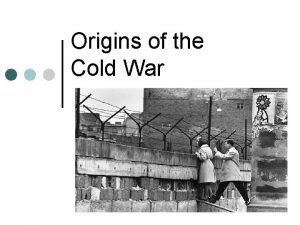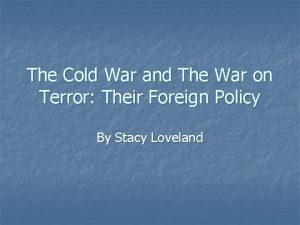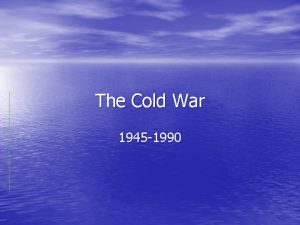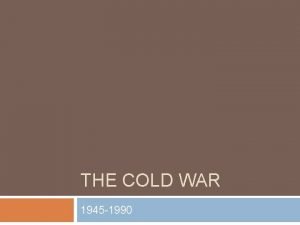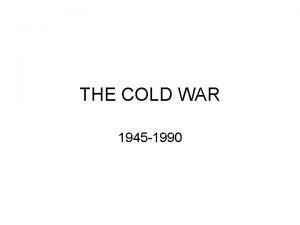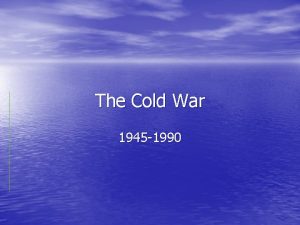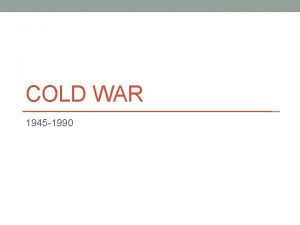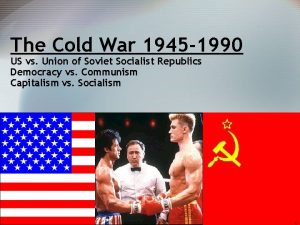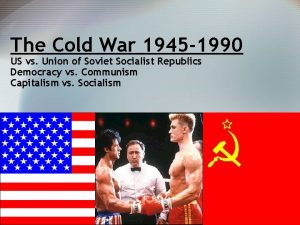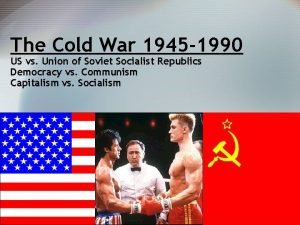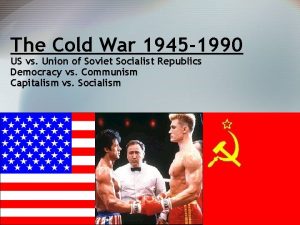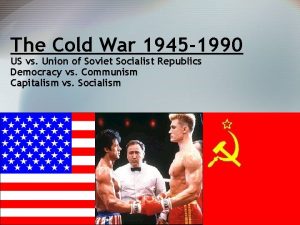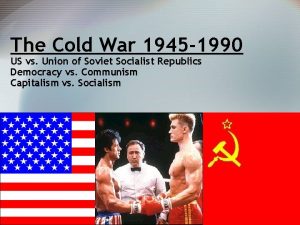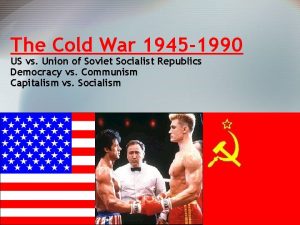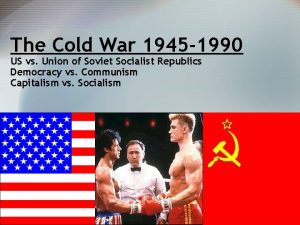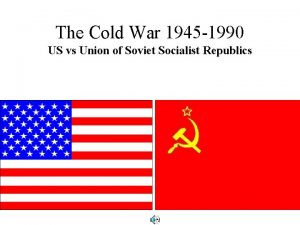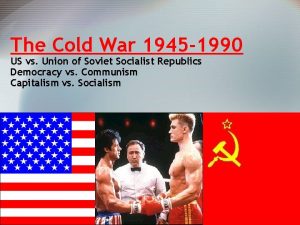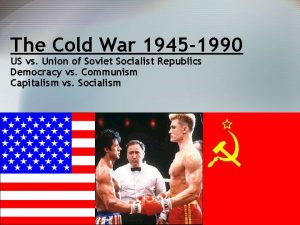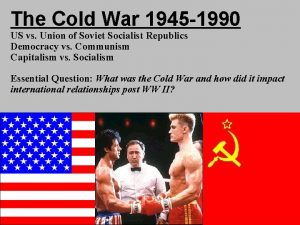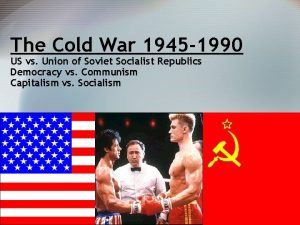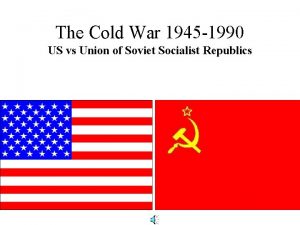The Cold War 1945 1990 US vs Union



























- Slides: 27

The Cold War 1945 -1990 US vs. Union of Soviet Socialist Republics Democracy vs. Communism Capitalism vs. Socialism





The Cold War • Political, strategic and ideological struggle between the US and the USSR that spread throughout the world • Struggle that contained everything short of war • Competing social and economic ideologies

Key Concept: How did the Cold War affect the domestic and foreign policies of the United States? Domestic Policies: Foreign Policies: • 1. Mc. Carthyism • 1. Korean War • 2. HUAC • 2. Arms Race –House Un-American Activities Committee • 3. • 4. • 5. Loyalty oaths Blacklists Bomb shelters Actors and writers protest the Hollywood Blacklist. • 3. • 4. Truman Doctrine Eisenhower Doctrine A 1950 s era bomb shelter

Key Concept: What were the six major strategies of the Cold War? The six major strategies were: • 1. Brinkmanship, • 2. Espionage, • 3. Foreign aid, • 4. Alliances, • 5. Propaganda, • 6. Surrogate wars. 1. 3. 2. 4. 6. 5.

Post WWII/Cold War Goals for US (Containment) • Stop the spread of communism –“Domino Effect” • Promote open markets for US goods to prevent another depression • Promote democracy throughout the world, especially in Asia and Africa

Post WWII/Cold War Goals for USSR • Create greater security for itself – lost tens of millions of people in WWII and Stalin’s purges – feared a strong Germany • Establish defensible borders • Encourage friendly governments on its borders • Spread communism around the world Excerpt from Winston Churchill’s “Iron Curtain Speech. ” “From Stettin in the Baltic to Trieste in the Adriatic an iron curtain has descended across the Continent. Behind that line lie all the capitals of the ancient states of Central and Eastern Europe. Warsaw, Berlin, Prague, Vienna, Budapest, Belgrade, Bucharest and Sofia, all these famous cities and the populations around them lie in what I must call the Soviet sphere, and all are subject in one form or another, not only to Soviet influence but to a very high and, in some cases, increasing measure of control from Moscow. ”

Truman Doctrine • 1947: British help Greek government fight communist guerrillas. –They appealed to America for aid, and the response was the Truman Doctrine. – America promised it would support free countries to help fight communism. – Greece received large amounts of arms and supplies and by 1949 had defeated the communists. • The Truman Doctrine was significant because it showed that America, the most powerful democratic country, was prepared to resist the spread of communism throughout the world.

Marshall Plan • In 1947, US Secretary of State Marshall announced the Marshall Plan. –This was a massive economic aid plan for Europe to help it recover from the damage caused by the war. • There were two motives for this: – Helping Europe to recover economically would provide markets for American goods, so benefiting American industry. – A prosperous Europe would be better able to resist the spread of communism. This was probably the main motive. Secretary of State George Marshall. A poster promoting the Marshall Plan


The Berlin Airlift: June 1948 -May 1949 • 1948: three western controlled zones of Germany united; grew in prosperity due to the Marshall Plan • West wanted East to rejoin; Stalin feared it would hurt Soviet security. • June 1948: Stalin decided to gain control of West Berlin, which was deep inside the Eastern Sector – Cuts road, rail and canal links with West Berlin, hoping to starve it into submission • West responded by airlifting supplies to allow West Berlin to survive • May 1949: USSR admitted defeat, lifted blockade Map of Berlin divided into zones after WWII Map of Germany divided into zones after WWII A plane flies in supplies during the Berlin Airlift.


NATO: North Atlantic Treaty Organization • In 1949 the western nations formed the North Atlantic Treaty Organization to coordinate their defense against USSR. • It originally consisted of: –America –Belgium –Britain –Canada –Denmark –France –Holland –Italy –Luxembourg –Norway –Portugal NATO flag • Since the fall of the Soviet Union in 1991, some former Soviet republics have applied for membership to NATO.

Warsaw Pact • Warsaw Pact: organization of communist states in Central and Eastern Europe. • Established May 14, 1955 in Warsaw, Poland • USSR established in in response to NATO treaty • Founding members: –Albania (left in 1961 as a result of the Sino-Soviet split) –Bulgaria –Czechoslovakia –Hungary –Poland –Romania – USSR –East Germany (1956) Greatest extent of Warsaw Pact

Senator Joe Mc. Carthy (1908 -1957) • Mc. Carthy, a Republican senator from Wisconsin, did the most to whip up anti- communism during the ‘ 50 s. • On February 9, 1950, he gave a speech claiming to have a list of 205 Communists in the State Department. • No one in the press actually saw the names on the list. • Mc. Carthy continued to repeat his groundless charges, changing the number from speech to speech. • During this time, one state required pro wrestlers to take a loyalty oath before stepping into the ring. • In Indiana, a group of anti-communists indicted Robin Hood (and its vaguely socialistic message that the book's hero had a right to rob from the rich and give to the poor) and forced librarians to pull the book from the shelves. • Baseball's Cincinnati Reds renamed themselves the "Redlegs. " Cincinnati Redlegs primary logo in use from 1954 -1959


House Un-American Activities Committee A committee of the U. S. House of Representatives to investigate alleged disloyalty and subversive activities on the part of private citizens, public employees, and those organizations suspected of having communist ties.


Julius and Ethel Rosenberg

Mc. Carthy’s Downfall Movie poster for the 2005 film Good Night and Good Luck about the fall of Joseph Mc. Carthy • In the spring of 1954, the tables turned on Mc. Carthy when he charged that the Army had promoted a dentist accused of being a Communist. • For the first time, a television broadcast allowed the public to see the Senator as a blustering bully and his investigations as little more than a witch hunt. • In December 1954, the Senate voted to censure him for his conduct and to strip him of his privileges. • Mc. Carthy died three years later from alcoholism. • The term "Mc. Carthyism" lives on to describe anti. Communist fervor, reckless accusations, and guilt by association. Arthur Miller’s play The Crucible was on the surface about the Salem Witch Trials. It’s real target, though, was the hysterical persecution of innocent people during Mc. Carthyism. (poster for 1996 film version)

Arms Race • Cold War tensions increased in the US when the USSR exploded its first atomic bomb in 1949. • Cold War tensions increased in the USSR when the US exploded its first hydrogen bomb in 1952. It was 1000 times more powerful than the Hiroshima atomic bomb.

Space Race • Cold War tensions increased in the US when the USSR launched Sputnik I, the first artificial satellite into geocentric orbit on October 4, 1957. – The race to control space was on. • April 12, 1961: Yuri Gagarin became first human in space and first to orbit Earth. • US felt a loss of prestige and increased funding for space programs and science education. • On May 25, 1961, Kennedy gave a speech challenging America to land a man on the moon and return him safely by the end of the decade. • Apollo 11 landed on the moon on July 16, 1969.

Sputnik

The U-2 Incident • USSR was aware of American U-2 spy missions but lacked technology to launch countermeasures until 1960. –May 1, 1960: CIA agent Francis Gary Powers’ U-2, was shot down by Soviet missile. • Powers was unable to activate plane's selfdestruct mechanism before he parachuted to the ground, right into the hands of the KGB. • When US learned of Powers' disappearance over USSR, it issued a cover statement claiming that a "weather plane" crashed after its pilot had "difficulties with his oxygen equipment. " US officials did not realize: – Plane crashed intact, – Soviets recovered its photography equipment – Captured Powers, whom they interrogated extensively for months before he made a "voluntary confession" and public apology for his part in US espionage
 The cold war lesson 1 the cold war begins
The cold war lesson 1 the cold war begins The cold war heats up: 1945 - 1969
The cold war heats up: 1945 - 1969 Chapter 26 section 2 the cold war heats up answer key
Chapter 26 section 2 the cold war heats up answer key The cold war begins 1945-1960
The cold war begins 1945-1960 1990-1945
1990-1945 Cold war sides
Cold war sides 1945 world war ii
1945 world war ii 1945 world war
1945 world war Union union all intersect
Union union all intersect Civil war union strategy
Civil war union strategy The union blockade during the civil war
The union blockade during the civil war What are the characteristics of the cold war
What are the characteristics of the cold war Truman speech
Truman speech Climax of the cold war
Climax of the cold war Cold war
Cold war Iron curtain cold war
Iron curtain cold war Cold war summary
Cold war summary Cold war iron curtain map
Cold war iron curtain map Cold war
Cold war Cold war superpowers face off guided reading
Cold war superpowers face off guided reading Watergate cold war
Watergate cold war The cold war vocabulary
The cold war vocabulary Postrevisionist
Postrevisionist Doves cold war
Doves cold war Agent orange and napalm
Agent orange and napalm Marshall plan cold war definition
Marshall plan cold war definition The cold war
The cold war Cold war who was involved
Cold war who was involved

